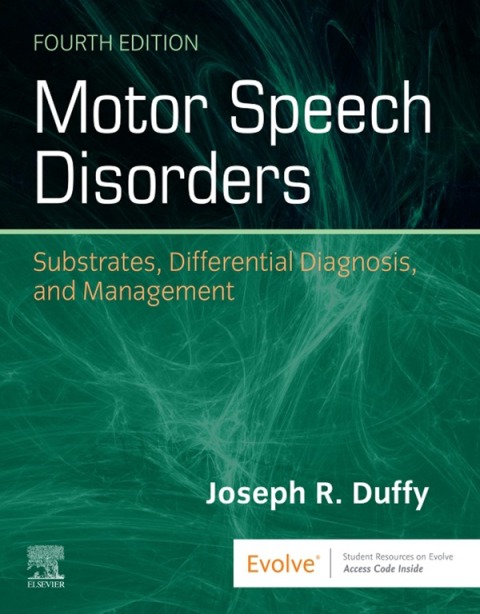Description
Efnisyfirlit
- Cover image
- Title page
- Table of Contents
- Copyright
- Dedication
- Preface
- Acknowledgments
- PART 1. Substrates
- 1. Defining, Understanding, and Categorizing Motor Speech Disorders
- The Neurology of Speech
- The Neurologic Breakdown of Speech
- Some Basic Definitions
- Speech Disturbances That Are Distinguishable From Motor Speech Disorders
- Prevalence and Distribution of Motor Speech Disorders
- Methods for Studying Motor Speech Disorders
- Categorizing Motor Speech Disorders
- 2. Neurologic Bases of Motor Speech and Its Disorders
- Gross Neuroanatomy and Major Neurologic Systems
- Primary Structural Elements of the Nervous System
- Clinicopathologic Correlations
- The Speech Motor System
- Higher-Level Speech Motor Planning and Programming
- 3. Examination of Motor Speech Disorders
- Purposes of Motor Speech Examination
- Guidelines for Examination
- The Motor Speech Examination
- PART 2. The Disorders and Their Diagnoses
- 4. Flaccid Dysarthrias
- Clinical Characteristics of Flaccid Paralysis
- Etiologies
- Speech Pathology
- Cases
- 5. Spastic Dysarthria
- Anatomy and Basic Functions of the Direct and Indirect Activation Pathways
- Clinical Characteristics of Upper Motor Neuron Lesions and Spastic Paralysis
- The Relationship of Spastic Paralysis to Spastic Dysarthria
- Etiologies
- Speech Pathology
- Cases
- 6. Ataxic Dysarthria
- Anatomy and Basic Functions of the Cerebellar Control Circuit
- Localization of Speech within the Cerebellum
- Clinical Characteristics of Cerebellar Lesions and Ataxia
- Etiologies
- Degenerative Diseases
- Speech Pathology
- Cases
- 7. Hypokinetic Dysarthria
- Anatomy and Basic Functions of the Basal Ganglia Control Circuit
- Clinical Characteristics of Basal Ganglia Control Circuit Disorders Associated with Hypokinetic Dysarthria
- Etiologies
- Speech Pathology
- Cases
- 8. Hyperkinetic Dysarthrias
- Anatomy and Basic Functions of the Basal Ganglia Control Circuit
- Clinical Characteristics of Basal Ganglia Control Circuit Disorders Associated with Hyperkinetic Dysarthrias
- Causes
- Speech Pathology
- Cases
- 9. Unilateral Upper Motor Neuron Dysarthria
- Anatomy and Basic Functions of the Upper Motor Neuron System
- Clinical Characteristics Associated with Unilateral Upper Motor Neuron Lesions
- Etiologies
- Speech Pathology
- The Perceptual Distinctiveness of Unilateral Upper Motor Neuron Dysarthria: Conclusions and Clinical Suggestions
- Cases
- 10. Mixed Dysarthrias
- Etiologies
- Vascular Disorders
- Speech Pathology
- Cases
- 11. Apraxia of Speech
- Anatomy and Basic Functions of the Motor Speech Programmer
- Nonspeech, Nonoromotor, and Nonlinguistic Characteristics OF Patients with Apraxia of Speech
- Etiologies
- Speech Pathology
- Cases
- 12. Neurogenic Mutism
- Motor Speech Disorders and Mutism
- Aphasia and Mutism
- Disorders of Arousal, Responsiveness, and Diffuse Cortical Functions
- Etiology-Specific Neurogenic Mutism
- Cases
- 13. Other Neurogenic Speech Disturbances
- Other Speech Disturbances Associated with Unilateral, Bilateral, Multifocal, or Diffuse Central Nervous System Abnormalities
- Other Speech Disturbances Associated with Left Hemisphere Lesions
- Other Speech Disturbances Associated with Right Hemisphere Lesions—Aprosodia
- Cases
- 14. Functional (Psychogenic) and Related Speech Disorders
- Functional Neurologic Movement Disorders—Some Basics
- Psychiatric Conditions that Can Alter Speech
- Conditions Associated With Functional Speech Disorders
- Volitional Disorders
- Speech Pathology
- Speech Characteristics Associated with Specific Psychiatric Conditions
- Cases
- 15. Differential Diagnosis
- General Guidelines
- Distinguishing Among the Dysarthrias
- Distinguishing Dysarthrias from Apraxia of Speech
- Distinguishing Motor Speech Disorders from Aphasia
- Distinguishing Among Forms of Neurogenic Mutism
- Distinguishing Motor Speech Disorders from Other Neurogenic Speech Disorders
- Distinguishing Neurogenic from Functional (Psychogenic) and Related Speech Disorders
- PART 3. Management
- 16. Managing Motor Speech Disorders: Broad Overview
- Management Issues and Decisions
- Approaches to Management
- Foundations for Behavioral Management
- Treatment Efficacy
- Evidence-Based Practice and Practice Guidelines
- 17. Managing the Dysarthrias
- Speaker-Oriented Treatment
- Speaker-Oriented Treatment for Specific Dysarthria Types
- Communication-Oriented Treatment
- 18. Managing Apraxia of Speech
- General Perspectives
- Management Approaches
- Principles and Guidelines for Behavioral Management
- Behavioral Management Approaches
- Neurodegenerative Apraxia of Speech
- Efficacy
- 19. Managing Other Neurogenic Speech Disturbances
- Neurogenic Stuttering
- Palilalia
- Echolalia
- Cognitive and Affective Disturbances
- Aphasia
- Foreign Accent Syndrome
- Aprosodia
- 20. Managing Functional (Psychogenic) Speech Disorders
- General Principles, Guidelines, and Strategies
- Practical Considerations
- Symptomatic Therapy
- Symptomatic Treatment for Specific Functional Speech Disorders
- Index





